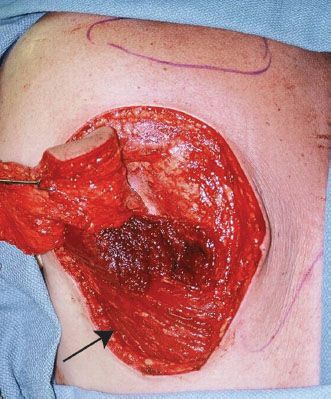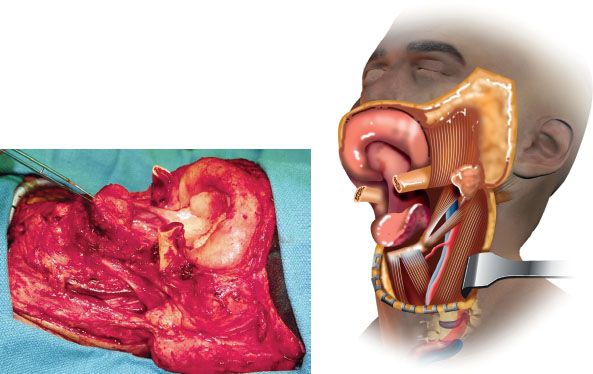FIGURE 18.1 Skin paddle design and elevation. A. Design of scapular and parascapular skin paddles over the left scapula Note the outline of the scapular spine and the scapular tip. B. The skin paddles have been incised to expose the underlying soft tissue, but the skin connection is maintained laterally.
The skin and subcutaneous tissues are then incised down to muscle or the fascia of the infraspinatus, as appropriate, and elevated in this plane from medial to lateral. Of note, I leave the very lateral edge of the skin intact initially to avoid inadvertent disruption of the skin segment. The skin is elevated to the lateral border of the scapula and then stopped to avoid disruption of the cutaneous pedicle. Usually, these pedicles can be identified on the underside of the flap during elevation. Likewise, the skin is elevated off of the deltoid, latissimus, and teres muscles and the latissimus muscle retracted inferiorly (Fig. 18.2). If a latissimus myocutaneous flap is to be harvested as part of a “megaflap,” the skin segment should be outlined and the latissimus flap can be harvested to the edges of the scapula at this time, with final connections made at the conclusion of the scapular harvest.

FIGURE 18.2 Skin paddle elevation is completed with the delineation of the latissimus muscle (arrow) inferiorly and the teres major muscle superiorly.
The teres major muscle is now isolated in 360-degree fashion near its insertion on the lateral scapular border and divided with care not to injure underlying vessels. The muscle can then be retracted with a Deaver retractor. The arm is retracted laterally and rotated internally, thus exposing the contents of the axilla. The proximal CSA can now be identified with its venae comitantes, running laterally into the axilla from the lateral border of the scapula. Fascial attachments can be divided over the vessels and the vessels followed into the axilla. The branches to the teres major must be divided to allow further dissection. I prefer small and medium clips to control these vessels. The TDA can be identified at this point going inferiorly, along with its branch to the scapular tip. If the harvest of the scapular tip and/or the latissimus flap is desired, the TDA is left intact. Likewise, if I feel that the length and caliber of the vessel are sufficient with the harvest of just the CSA, further dissection of the vessel is not necessary. Otherwise, the TDA pedicle is divided, and the artery and venae comitantes are followed to the subscapular vessels. Again, usually the venae comitantes form one vein, which may then divide prior to entering the axillary vein. Meticulous dissection and hemostasis are critical at this point to allow identification of all anatomic structures and avoid injury to the vessel. Blunt dissection is discouraged, and hemostasis can be aided by the use of bipolar cautery.
Once the vessels are identified and freed in 360-degree fashion from the axillary vessels to the lateral border of the scapula, the harvest of the bone can begin. The glenohumeral joint is palpated, and the superior border of the bone harvest is defined 1 to 2 cm inferior to this landmark. The required length of bone is then measured, with some leeway, and marked. If the tip is to be included, it is best to preserve the angular vessels and so dissect these free from the tip to the proximal pedicle. A bone width of 3 cm is then measured from the lateral border, and incisions are now carried through the infraspinatus muscle to isolate the bone margins, with division of the periosteum. This area is relatively vascular, and the patience of the surgeon is necessary to gain complete control of periosteal vessels. The superior bone margin has several large vessels nearby, and these are near the vascular pedicle, so careful control in this area is especially important. Once defined, osteotomies are carried out with a sagittal bone saw, with care not to injure the vascular pedicle, which should be protected with small retractors during this maneuver. Finally, the bone is released, and now incisions are carried just deep to the bone, through the subscapularis muscle, again with care to visualize and not to injure the vascular pedicle. Once the bone is released, bleeding is controlled and final soft tissue attachments at the skin/adjacent flaps are divided, and any further dissection required on the proximal pedicle is completed. The flap is now ready for harvest with the transection of the CSA or subscapular vessels. The donor vessels should be controlled with permanent 2-0 silk sutures.
Meticulous hemostasis is assured, and closure of the incision is begun. Small drill holes are placed in the new lateral border of the scapula approximately 2 cm apart, and the teres major muscle is now approximated with 2-0 absorbable sutures (PDS or Vicryl). The skin is widely undermined and closed in layers over flexible drains, which are placed to bulb suction. The patient is now rotated into the supine position for reconstruction. A sterile dressing can be applied now or at the conclusion of the case. The surgical defect is now inspected (Fig. 18.3).

FIGURE 18.3 A through-and-through composite defect of the anterior oromandibular region, as viewed from inferiorly. Note the remaining lateral mandibular segments and the small remnant of the base of the tongue.
An osteotomy may be necessary during plating of the scapular bone (Fig. 18.4
Stay updated, free articles. Join our Telegram channel

Full access? Get Clinical Tree


